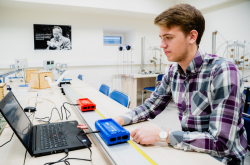ITMO SAP Next-Gen InnoJam "TimeHack" is an experimental seminar that makes use of design thinking methodology. Its goal is to use SAP's products for creating innovative applications that have to do with using Big Data for time management and motivating developers. We have to note that SAP Next-Gen Lab was created for the generation Z, i.e. students and specialists who wish to pursue their careers and find a practical application for their skills rather than study theory only.
The ITSK company is a subsidiary of Gazprom Neft, a systems integrator and software developer. ITSK specializes in providing services and introducing projects in the field of information technologies and enterprise management systems, developing industry-specific software and supporting IT-infrastructures. The issue that ITSK's representatives wanted help with was the absence of an effective tool for managing the developer team and monitoring the tasks their IT specialists work on.
Searching for an effective management instrument is the internal task of my department that focuses on supporting solutions developed for Gazprom Neft. I have a great many employees, most of which work in different time zones and rarely meet in one place. So, we have to quickly and efficiently manage the activities and workload of our employees. For now, we're using Excel to do that, which is not really effective when working with large amounts of data. So, we've decided to consider introducing new instruments that would've made our job easier. For us, it's important that the product we'll be using is of Russian origin. Our main goal is not just getting a system with high usability, but also creating an effective tool for managing and motivating personnel. The key indications for assessing the prototypes are minimizing the production budget and the interface usability. It is very important that the interface would allow to see all the information space on one screen, and present all the operative records necessary for making managerial decisions," explains Madina Eliseeva, director of ITSK's Technology Department.

"As the task wasn't exactly well-defined, a proper way to go was to use the methods of design thinking, work on the problem's statement, immerse into the expert's real agenda, and first attain a better understanding of the task at hand. We also had to consider several scenarios of solving the problem. Doing that was easy thanks to the event's format, as the methods of design thinking are aimed at searching for unorthodox solutions to non-formalized tasks. The hardest part of design thinking is searching for the question. The seminar's participants found the question and had it approved by the customer company. We expect that the next step would be making the decision about keeping these teams, partially or in full, and presenting the solutions during the SAP forum in April 2019," comments Yuri Kupriyanov, Program Coordinator of the University Alliance in the CIS.
Projects
Team AE, AE-project system
Participants: Dmitry Novik, Aleksei Kohanov, Stanislav Utikeev, Marina Smirnova
The project's idea is to relieve the department heads and free them from performing routine work. For example, it is possible to automate the process of choosing developers who would work on particular tasks by using machine learning technologies. For one, machine learning can be used to create ranked lists of employees for performing particular tasks. The system allows to automatically bolt out those developers who don't focus on the field in question, as well as those who don't meet particular requirements (work speed, efficiency, ability to meet deadlines, etc.).
In order to ensure the transparency of the work process, the developers should upload their results by themselves, and specify their progress at this particular moment. In case the developer fails to do that, the system won't let them finish their task. According to the participants, such an approach will help increase the developers' culture and help their seniors analyze what's going on. What's more, this method will help gather the statistics for the task's progress (how much time does it take and what kind of actions does this kind of work involve). The diagrams will help predict risks and failures, the possibility of finishing a particular project on time and hence the proper ways of distributing the employees' workload.

Another of the team's ideas is to create a competitive environment. Based on such indications as speed and the number of successfully completed tasks, the system will also make a list of top employees in different fields. Such specialists will help developer teams during emergencies when the risk of missing the deadlines is really high. Statistics will also help understand which types of projects are easy to complete and which call for additional time and effort.

Team WhatSAP, Sistema X
Participants: Dimash Torehanov, Yulia Makarenko, Igor Sushentsev, Dmitry Ofitserov, Roman Lebedev
The team's members proposed a system in the format of a web-service. It offers senior managers an opportunity to monitor their employees' work, and developers will be able to use it to check the tasks at hand. The managers will also be able to use this service to appoint new tasks. What is more, the service features a list of available tasks that developers are free to take up.

Another important issue that the team worked on was that of developers' motivation to do more tasks and execute them better while spending less time. The team proposed a gamification approach, i.e. assigning a character to each developer and maintaining a leaderboard where their achievements will be visualized.
Another of the system's solutions is a time tracker. Usually, every developer has a number of planned tasks. A time tracker allows them to track the amount of time spent on each. The team plans to develop an instrument for every task that will keep track of time and thus help estimate the deadlines. The system will also allow its users to chat with consultants, and notifications will inform every developer of all new changes made to the system.

"I brought my students to InnoJam, but I also decided to work on the case myself. My idea is based on the real options theory. It is used for assessing the labor of employees characterized by high uncertainty; in the West, that would be senior management and creative professionals. If the company's value grows as a result of successful work, the options become more valuable and are sold to the employees. If the company's results become worse, the options fall in value, and so the employees lose their bonuses. In 2016, this project won the Nobel Prize in Economics. I used this approach to create a system for calculating rates for awarding employees. The main problem that I worked on is the following: oftentimes, the end-of-year bonuses are based on an employee's work throughout the year. According to the expectancy theory, the sooner a person gets it, the more pleasant and useful it is. This is why options are used: instead of making people wait until some long project is completed, they are nominally given an impressive amount of options that stimulate them. Today, if you want a successful business, you need a system that shows the possible risks and how employees cope with them, whether they manage to complete their tasks in these conditions or not. In Russia, few people know enough about the real options theory, mostly these are people who study Western financial instruments and gets resources from the Western markets," says Vladimir Kosovtsev, an associate professor from the Faculty of Technological Management and Innovations.
The event was conducted within the framework of the UN's sustainable development agenda.




